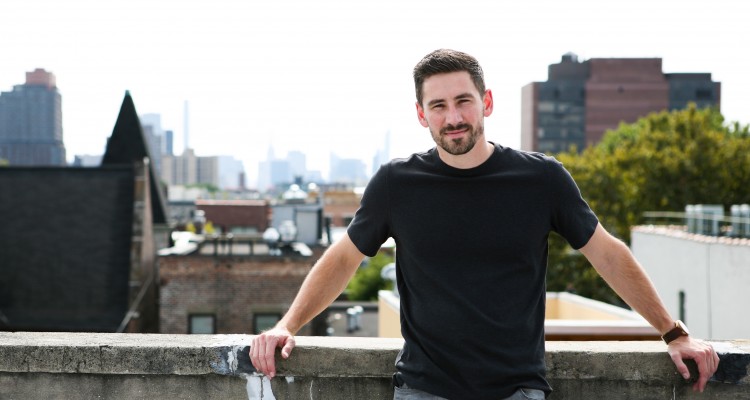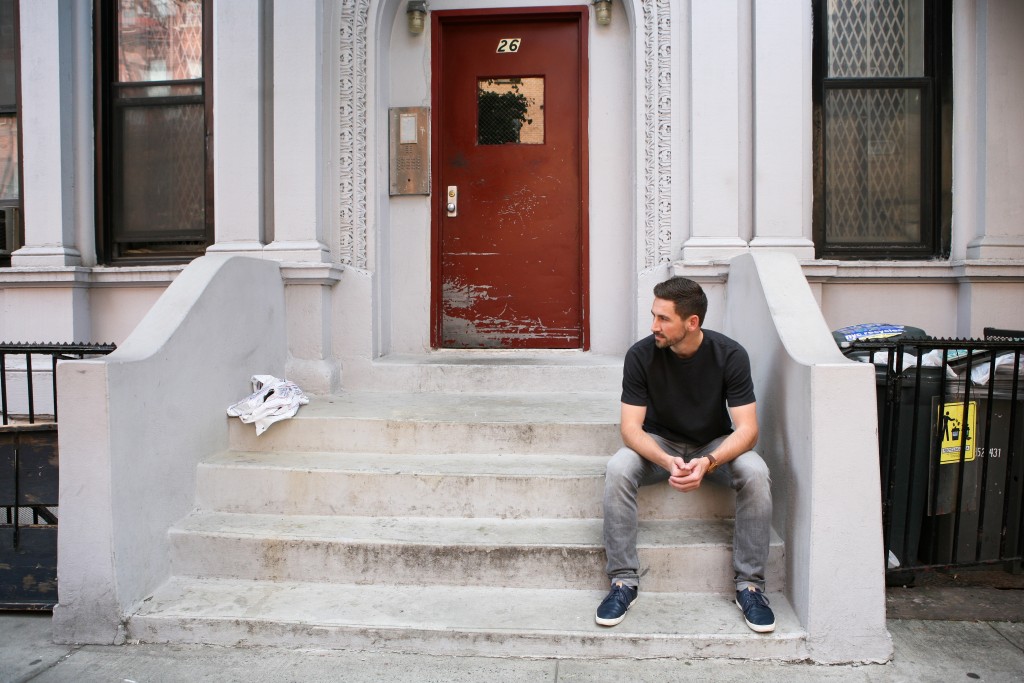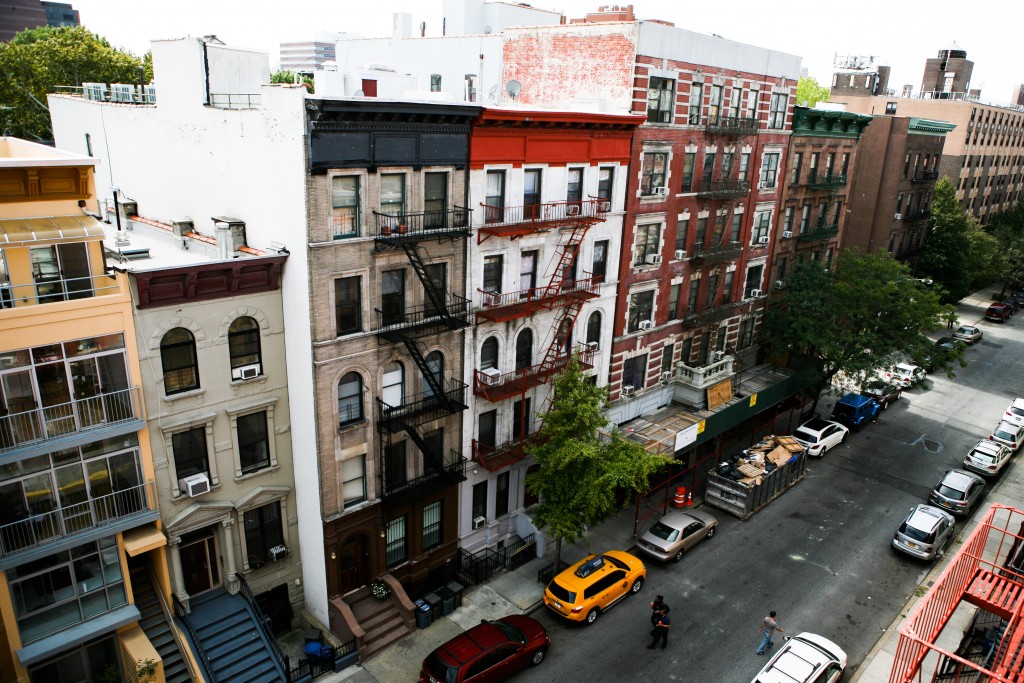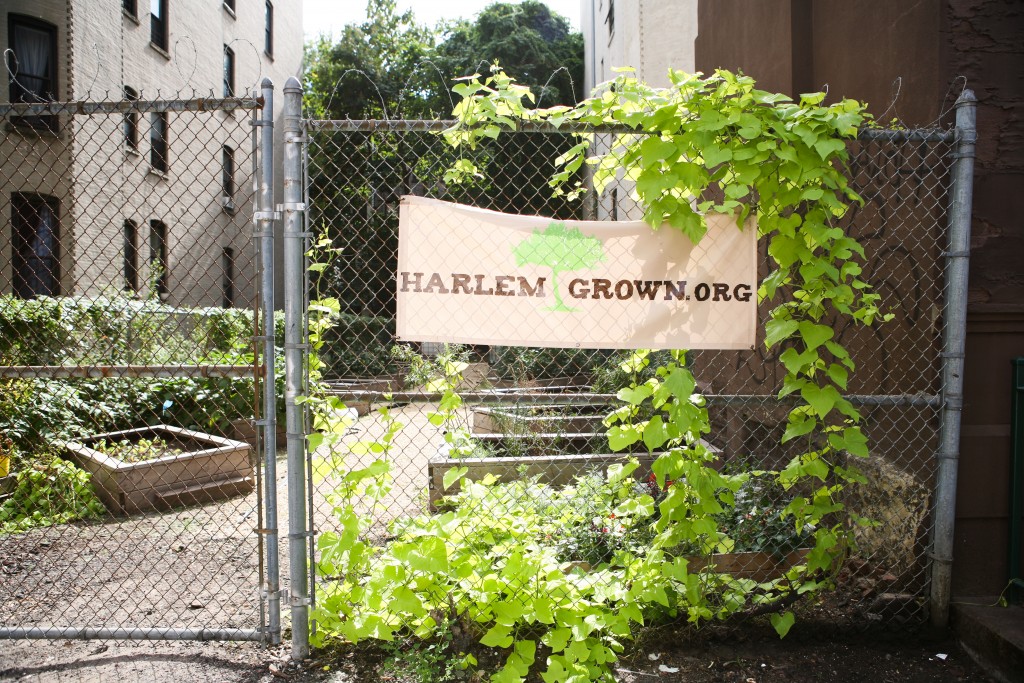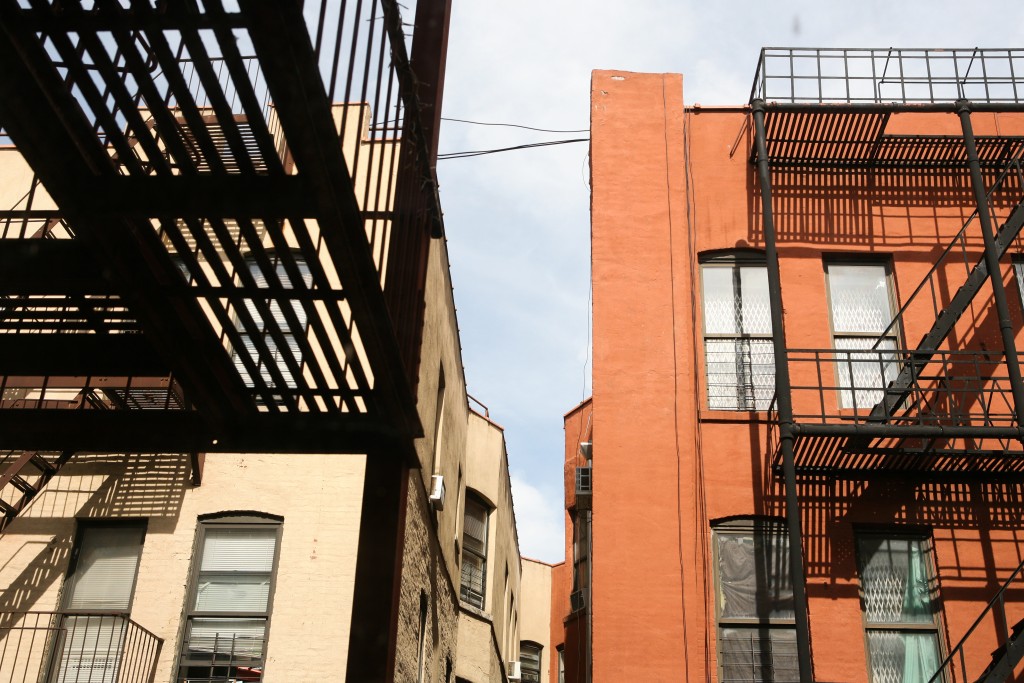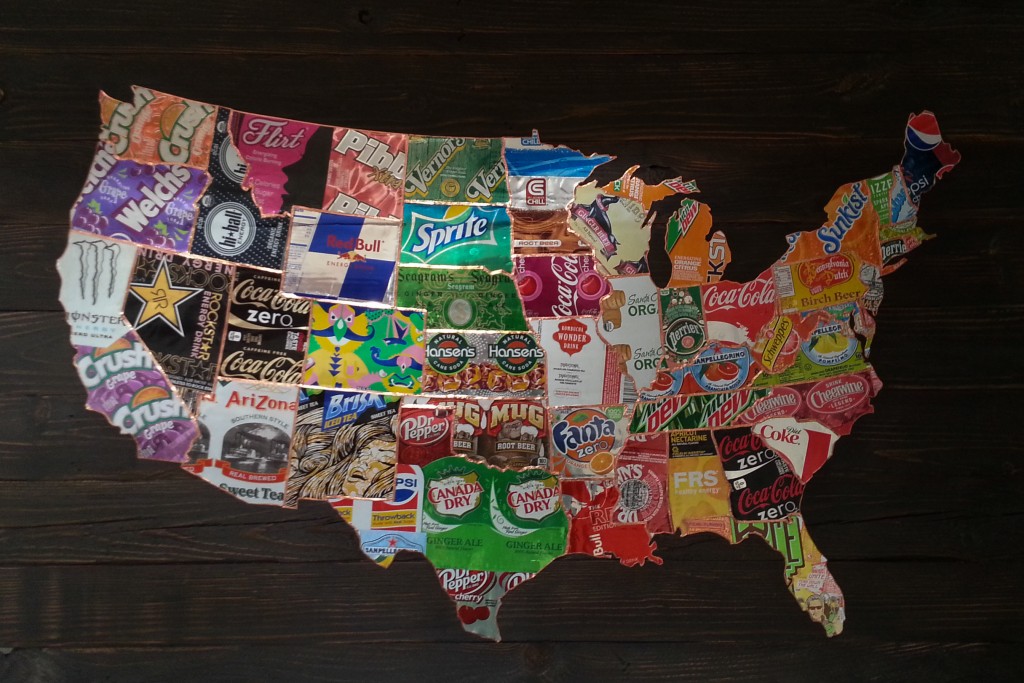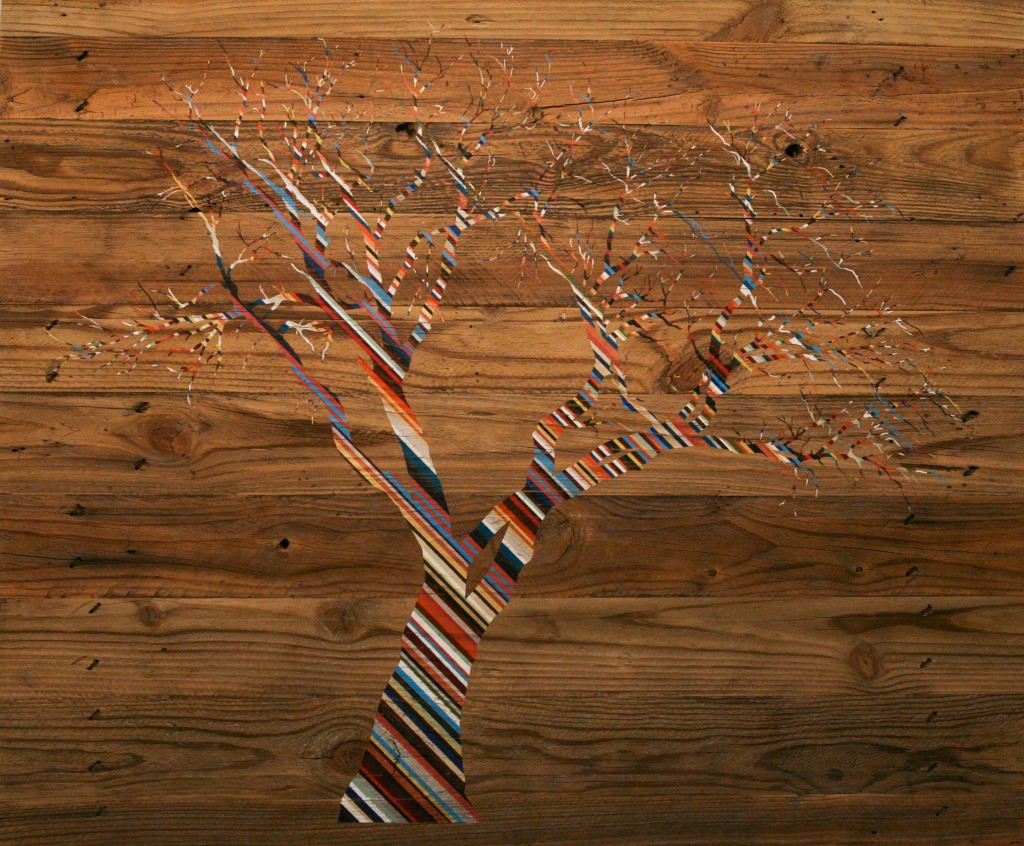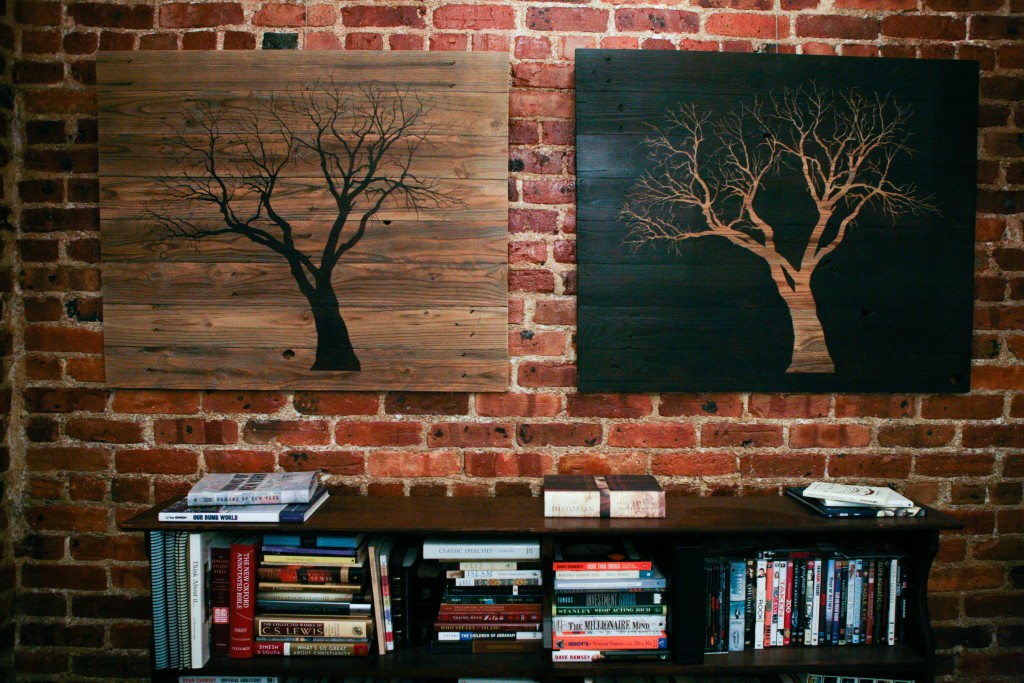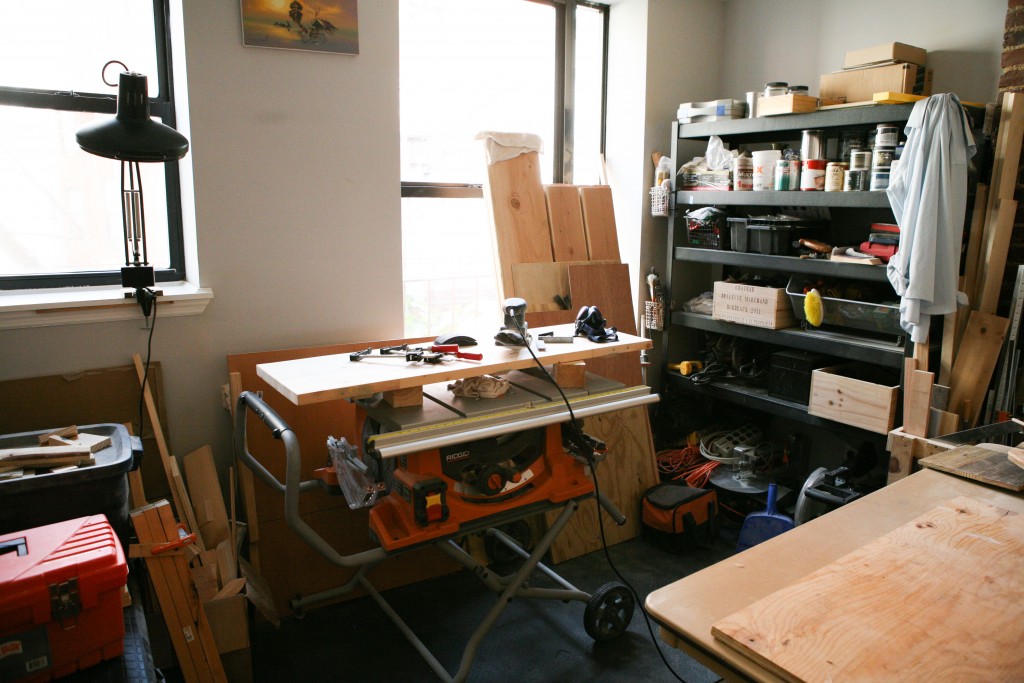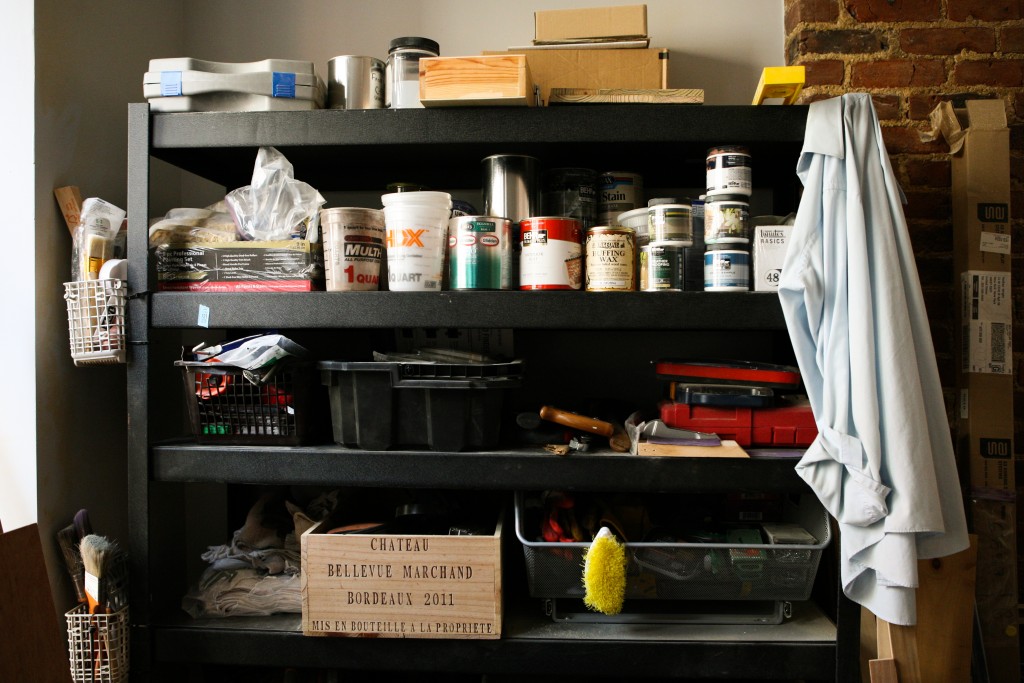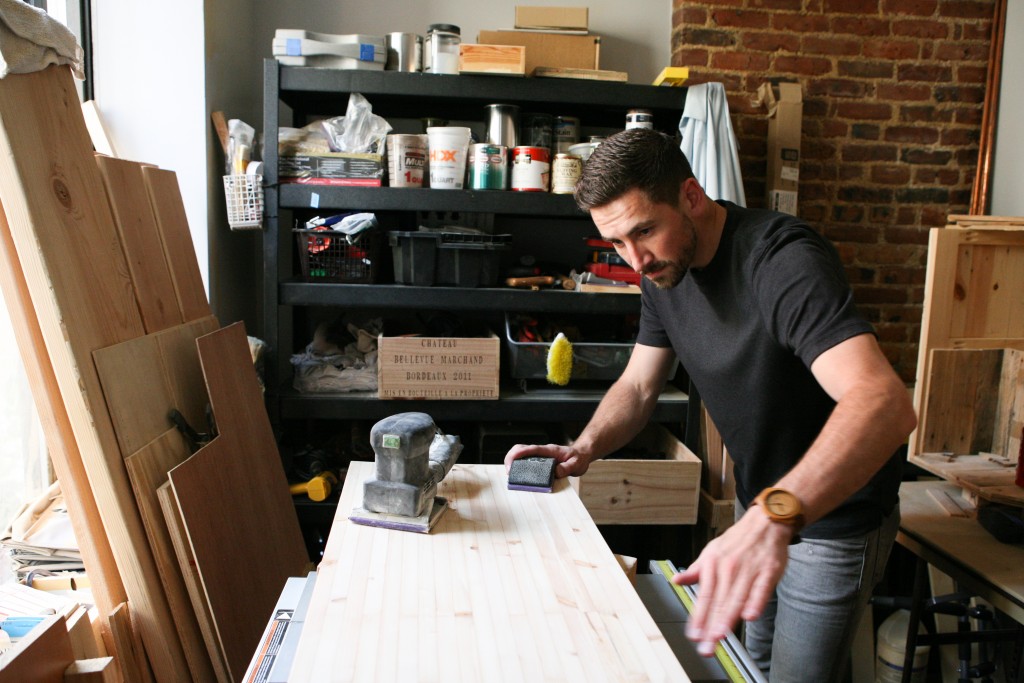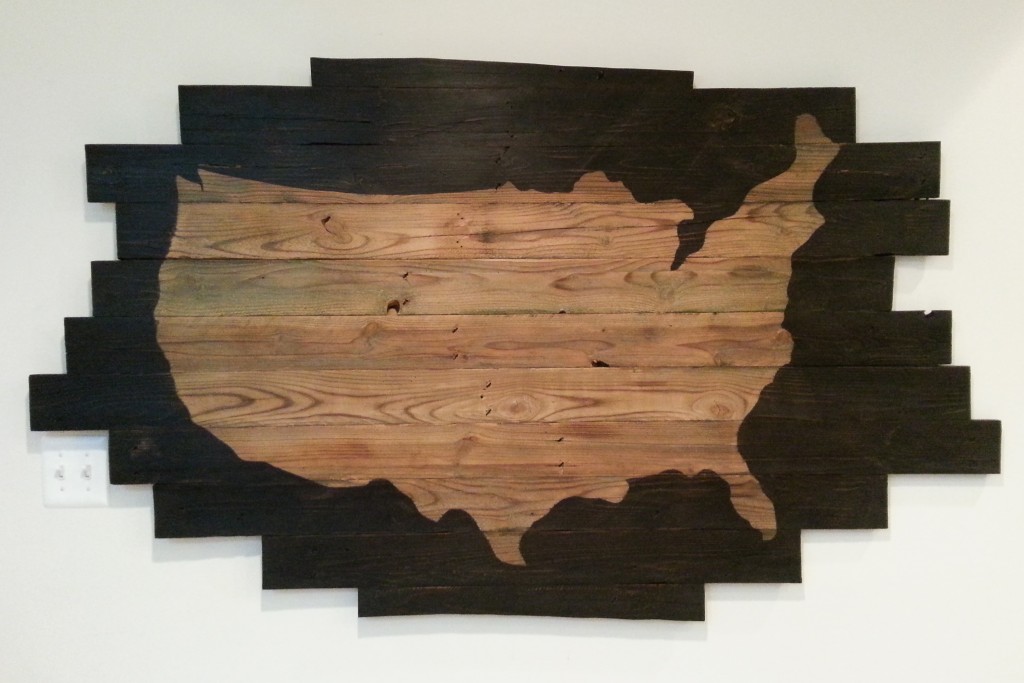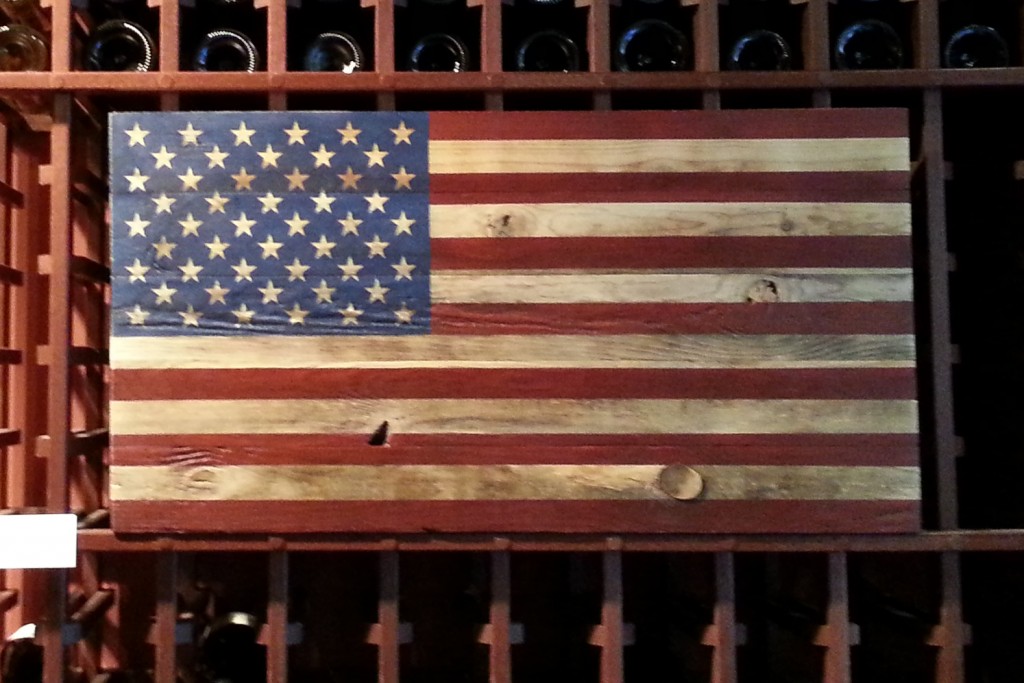I’m on my way to meet with artist Nate Wright at his Harlem apartment. It’s unusually warm for an afternoon in late September. After stepping off the train, I pass by several vendors selling fruit or vintage clothing and then turn the corner to my destination. As I navigate around scaffolding where a few men are giving some stairs a fresh coat of paint, my attention is drawn to the variety of colors along the street, the apartment buildings donning a variety of yellows, blues, reds and browns. I notice a small urban garden tucked between two apartment buildings and admire the greenery climbing the fence. Inside his apartment, Nate shows me his studio, a small room tucked behind two double doors just off the main living area. The room is small but I’m impressed by how he has utilized the space and how everything seems to have a place. I’m also happy to see my favorite pieces by Nate, an installation titled “Decision” (image 7 below), featured prominently in the living room. It was seeing these pieces in a dining room in the DC area that originally piqued my curiosity about the process and the artist, who I later discovered was someone I already knew! It is now my pleasure to introduce him to you.
Where are you from originally and what brought you to NYC?
I grew up in Utah but spent the last few years living in the DC Metro area. After nearly six years of living in DC I realized I needed a change and already being on the East Coast, I thought New York a natural option. It helped that I already had social connections here. Having lived in DC I had visited NYC a half dozen times or so over the years and I’ve always loved the energy of the city. It’s been challenging moving here but also incredibly inspiring because there is so much happening in so many different areas.
Can you tell us a little a bit about your current neighborhood? Why did you choose Harlem?
Choosing Harlem initially was a function of cost and space and what was available during the few days I had to find a place. I initially wanted to look in Brooklyn because of the reputation for being an artists haven but was having a hard time finding a place that was a decent size that was also affordable and accessible by Subway. When I started looking in Harlem I realized that it hit all of those practical boxes for me. After living here for almost a year I’ve found that Harlem is just one of a dozen little sections or neighborhoods of New York that has its own drumbeat, its own history, and its own cultural uniqueness. I love that about it. I love that about New York. Each neighborhood is different and has its own style. I love that I get off the Subway in Harlem and even though some of the Brownstone apartment design aren’t very different from the Upper East Side, or the Upper West Side, or parts of Brooklyn, it still has its own unique feel. The air, the people, the interactions on the street, all of that makes me love that I chose to live here. I especially love finding what I consider “architectural gems,” little buildings or aspects of buildings where architects and designers took a little bit of extra time making something beautiful. Sometimes I notice these in even the abandoned buildings that are under renovation, or need to be renovated. I see through the dilapidated nature and recognize the original beauty that once was there and is still hidden behind the crumbling facades. Most frequently these things are at a height that the standard street walker would never see unless they take the time to pause and look up. I love that about New York, the hidden gems in every neighborhood.
Were you interested in art as a child? If so, what were you drawn to? Did your parents encourage your creativity?
I was interested in art as a kid, but mostly I was interested in learning how things worked. My mom signed me up for some formal art classes from an artist in my neighborhood when I was 10 or 11. Those lasted for a couple of years and were mostly watercolors with a little bit of inkdot work in there. I still think I have some of those pieces tucked away somewhere. After we moved the summer I turned 12 I no longer did separate classes and just had the standard middle school art classes. Despite no longer doing art classes I have always liked figuring out how things operate, how to build things, and why they work. I watched my dad build a computer when I was 11 and thought it was the most incredible thing and I started taking apart broken electronics or items from relatives to try to figure out how and why they work. From that excitement my parents have been good about encouraging exploration of ideas, knowledge and personal creativity. My father use to be a photographer and turned a bathroom in our house into his own darkroom. Years later he saw a particular style of painting and loved the idea so much that he created his own pieces and had them in a few galleries himself before going on to become a writer and publishing a number of books. My mother was a seamstress and designed wedding gowns for a large pattern company in New York City and later she started her own interior design business doing Faux painting for high-end residential and commercial spaces. I spent a lot of hours in college working with her on projects and learning from her experience and techniques. I would say as a result of my parent’s own lives and creative projects that they were very supportive of creativity growing up but due to the nature of their work they weren’t pushing for us kids to be artists or poets or creative in that sense, it was more just a part of who they were and how they lived. I had been creating pieces for a couple of years in DC before my parents came out to visit. I had talked to them about my art and sent them pictures but those pictures don’t really provide a sense of the work because you can’t experience the detail, the contrast, or the size. Small photos limit the viewers perspective and experience. I enjoyed seeing their surprise and amazement when they saw the pieces in person because they finally got to experience the pieces.
When did you start working with wood? What are the pros/cons of working with this medium?
I started working with wood as a form of art just a few years ago but that doesn’t really pain the whole picture. I was first introduced to a proper wood shop by my grandfather, he had a great little shop in the basement of his house when I was young. Back then I was too young to actually learn there and wish I had been older before he moved and sold everything, I still have a bookcase that he made. In junior high school I took a shop class and in high school I built the sets for our high school theater company. Throughout high school I also worked a series of odd jobs that all contributed to giving me different experiences with wood and art. One summer I worked construction with a friend of my fathers ripping out old windows and installing new windows and molding. Another time I worked for a startup company in a neighbor’s garage where we would build fancy bulletin boards with “antiqued” frames and fabric backing, the types of things you see all over Pinterest and Pottery Barn now but weren’t available back then. I did a lot of painting and sanding of those frames to make them look worn and antiqued and each one was a unique as a result. I only worked there a few months but it gave me a new appreciation and understanding of process and creativity versus mass production. Back then I was paid per piece so it was in my interest to learn how to be more efficient in all of my steps and to track everything to minimize mistakes and improve efficiency but due to the nature of the product it still needed to have some artistic flair to keep the customers satisfied.
One of the biggest challenges of working with wood is understanding how it changes. In that area I feel that I’m very much a beginner. There are so many different types of wood, they each respond differently to various environmental conditions, some types are harder than others, some heavier and stronger, and some cut easier based on the grain of the wood. The biggest challenge is knowing whether or not the wood is going to warp or significantly expand or contract as the humidity or temperature change. For many of the art pieces I’ve done it doesn’t matter if they change because I reinforce them so I’m not worried about their structural integrity and any expanding or cracking only enhances the look, since they are designed be rustic. However, I’ve noticed how some of the early pieces I made have changed over the last few years and it’s made me realize how challenging creating some pieces can be, especially if a client likes something for a particular look and a few years later realizes the wood has cracked that could be a problem. Personally, I like the change. I like the character it adds, after all I’m primarily using aged worn pieces of wood so additional splitting isn’t something I worry about from an aesthetic view, it’s enhancing but it does present a challenge from an client expectation basis.
Tell us a little bit about your process. What kind of woods/materials do you use? How much time to you spend on a piece? Do you offer commissioned work?
It all started as a “what if” idea, a let’s see if I can do this and it’s just morphed from there. The first piece I ever did was simply a knock off of something I saw in a magazine article and I thought, I have the wood, I have the tools, I can make that and so I set about figuring out how to do it. I’ve learned a lot over the course of making various pieces, some things I found really work well and other things don’t. Some processes are easier than others and taking more time on one step will save me more time later on in others. The one thing I’ve been very good about doing is tracking the steps I take on each project and the total time each takes. Part of that is the business background in me, I want to know where I’m spending the most time and what takes the most time for each project. In the various iterations I’ve done on some of my pieces I’ve already cut hours off the initial product. Now some of that is just the nature of learning to do something, but some of it is figuring out how to do a step better than I had previously. The total amount of time I spend on each project various. I think the least amount I’ve spent on a project was about 10 hours and the longest on a single project was over 40 hours of what I call working time, the time I’m actually doing something. I don’t count the time I have to wait, for glue to dry, or some of my design time in.I am willing to do commissioned pieces and have done a few already for people. Those are often fun because part of the challenge is people have often come to me with ideas of thing I haven’t done yet and things that I’m not sure if I can do. The challenge of piecing the puzzle together and working out a plan to give them what they want is some of the best part of the creation process. It’s also some of the most time consuming because a lot of thought and sketches go into the design even before I start building the project.
Do you have any other interests/hobbies that influence your work in any way?
I often answer this question by saying “Everything!” It feels cliche to answer that way but I can’t say it any other way. I read an article recently about an architect who designed a building in Australia that is inspired by Beyonce’s body and I thought, “Yes, exactly! That’s Everything!” The world has such a rich selection of artwork, poetry, design. I love it all. I especially appreciate really good design. The way a restaurant is designed to minimize lines, how the handles on a door let you know whether you should push or pull without having to think about it just by their shape, those are the little things I notice and appreciate in the world around me. Since I primarily work with wood, I’m always paying more attention to things that are designed with wood, whether that’s wandering through Restoration Hardware looking at how they designed their new line of tables to the interior decorations in a restaurant or other commercial space where a wall or counter is built with wood. I’ve also had friends send me pictures of things they see and some tell me that my stuff is better than what they see and others ask if I could create something similar. All of those experiences help me think about new ideas and possibilities for what I’ve done and what I could do.
You enjoy traveling. Are there any places that especially inspire you artistically? Where would you like to go next?
I love traveling. I love seeing new places and learning how people live, think, and approach life in other areas of the world. I love the immense beauty of the landscapes in Iceland, Switzerland, and Norway. I love the cities of Europe because their history, their art, and their architecture are so much older than what is available in the United States. Some of the old cathedrals are mind blowing to me in the scope of their design, their artistic beauty, and the detail, especially when considering these were created at a time when there were no computers to run simulations on material stresses and foundations and there were no cranes and power tools. The craftsmanship is phenomenal. One place I would love to visit is Cappadocia, Turkey. I went once before but didn’t stay long and that was before I knew of the vast underground cities they have there that were created centuries ago. They have a series of tunnels and rooms extending multiple stories underground that can house tens of thousands of people for months on end and they are continually discovering new levels and new rooms. One thing that amazed me when I first heard about it was learning that the kitchens there funneled the smoke from the fires up and out several kilometers away from the entrances so that even if smoke was discovered by an invading army they wouldn’t be able to locate the entrances to the underground city. It’s ingenious and amazing for the time. Besides Turkey, I would love to visit New Zealand I’ve heard amazing things about the scenery, the people, the food, and the lifestyle so much so that everything seems just perfect there. I’m almost afraid to go for fear I’d never want to leave, which wouldn’t be a terrible thing either.
Are there any new projects or other creative endeavors on the horizon?
I have dozens of ideas but not nearly enough time or space to build or create. I’ve drawn up plans for various types of furniture designs and I create lists of individual and larger art projects I want to do but it’s challenging to find the time and know where to focus my efforts. One thing I didn’t expect in moving to New York is how much more challenging it would be to create. I have dedicated art space but it’s so limited in size that working with wood there is hard because each step requires completely reconfiguring the room and that takes more time away from creating. I have a couple of furniture projects in the works that I want to get finished before doing some more artistic style pieces. I haven’t decided what I’m doing next but I’ll consult the growing list of possible projects and then decide from a combination of that, any client requests, and whatever has inspired me most recently.
Do you have a favorite artist/artists? What do you like about their work?
I have a hard time picking favorites because I love a broad variety of work. I love the designers and writers at The Great Discontent for their publication. I think it’s well done all around and I’ve enjoyed reading both the print and online versions. I took an art history course my freshman year of college and fell in love with Caravaggio’s work. I love the deep hues and the stark contrast between the image in the foreground and the darkness that permeates the background and all of the paintings space. I’ve been to a number of shows in the last few years of lesser known or aspiring artists and loved the variety of the work. I visited 5 Pointz in NYC before I moved to the city which was a large multistory warehouse that had a ton of exterior wall space that artists were able to work with. I think that was a sad day when they tore it down to replace it with condominiums because the talent and the overall immersive experience there was phenomenal and the city and the developers gave up too much through the change. I personally love work that wows me. The ones that make me do double takes as I’m just walking by and that keep me coming back. I’ve been trying to place my finger on what it is that draws me in and I think it’s a sense that I can feel the artists emotions emanating from their piece and I can relate to it. There was a short-term show years ago called the G40 Summit in the DC Metro area and a number of artists there drew me in, one piece in particular was of a woman sitting at a table pouring her coffee slowly out of her mug while the background was muted and the coffee spill flowed to the edge of the frame. I wanted so badly to buy the piece but at the time couldn’t afford it, sadly the photo I took of the piece with the artist information wasn’t a good enough resolution for me to look them up years later. I would still buy that piece given the opportunity. I think that’s what I love about art, it can be immensely powerful and speaks to each person in its own unique way. What one person hates, moves another to tears, it’s incredible.
Is there anyone you would love to collaborate with?
I would love to collaborate with Elle Luna on a project. I think she is incredible and inspiring in pushing people to explore their creative side. She recently did a 100 Days Project that I thought was absolutely brilliant because it created a global community of people working each day to do something creative. I loved the way she used the idea to not only push herself but to inspire others to push themselves into new areas of creativity. At the end of the day that project was all about showing up, being present, and dedicating oneself to the creative process each day.
Thank you, Nate, for showing us around your neighborhood and studio space.
You can keep up to date with Nate’s work or inquire about commissions on his website: wrightdesigns.nyc.
You can also check out his 100 days poetry project inspired by Elle Luna here: @inconveniencedinny.
Photography by Rebecca Reed excepting images 5, 11 and 12 courtesy Nate Wright.

